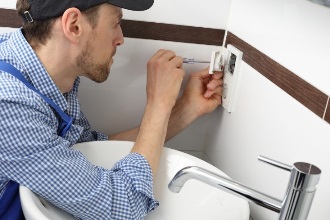How GFCIs Save Lives
From the time they were introduced in 1973, ground fault circuit interrupters (GFCIs) have reduced the number of electrocutions by 83 percent, according to the Electrical Safety Foundation International. These safety devices detect when an electrical current is moving through an unintentional path (such as water or a person) and immediately shut off power to prevent injuries. They are used inside and outside of homes and commercial buildings in areas where water or moisture is nearby. There are also GFCI circuit breakers that protect a whole circuit of outlets.
GFCIs are equally as important as smoke detectors in residential buildings — and like smoke detectors, they're required by code. Homes built before the 1970s should be updated to include GFCI outlets in any rooms with electrical access near a water source.
How They Work
 If water contacts a device plugged into a GFCI while the device is turned on, the GFCI senses a short circuit and interrupts the connection.
If water contacts a device plugged into a GFCI while the device is turned on, the GFCI senses a short circuit and interrupts the connection.
The GFCI's inner mechanics monitor the temperature difference of the electrical current running between the loop of the hot and the neutral wires. When it detects a temperature imbalance, the GFCI trips the breaker in the outlet, stopping the flow of electricity. It prevents any further electrical current from passing through until the outlet is manually reset.
Testing a GFCI
These types of devices occasionally break or wear out. Newer GFCIs have a light indicator that alerts homeowners if there is a problem, along with a reset button, which closes one of the circuits and disables the entire outlet. To test the GFCI, simply press the "test" button, then the "reset" button. The power in the outlet should turn off at the test and then turn back on after the reset.
If a circuit is damaged — or was installed incorrectly — the reset button will not click into place. The problem could be a bad GFCI outlet or a broken or frayed wire. If the wire is broken or frayed, the electricity can heat that wire and potentially cause a fire at the outlet or an adjacent wall, ceiling, or floor. Encourage homeowners to test their GFCIs monthly to identify any potential problems as soon as possible.
How to Install a GFCI
GFCIs are easy to install if you understand the concept of electrical flow and know which lines are "hot" (meaning they carry live electricity) and which are neutral. Carefully read the manufacturer's instructions before installing a GFCI. Ensure that the circuit breaker for that outlet is off and there is no power at the outlet before you begin.
GFCI receptacles have terminal screws on both sides. One side is the "line" and the other side is the "load." Each wire must go on the correct side:
- The black wire is the load wire (meaning it has live electricity). It is installed on the "load" side.
- The white wire is the neutral wire and goes on the "line" side.
- The green wire is the ground wire (the wire that carries electrical current into the ground). It should be connected to the bottom screw of the GFCI.
If there isn't an existing ground wire in the wall box where you plan to install the GFCI, do not install it. The ground wire safely diverts the current and is critical to preventing injuries.
Installing, testing, and repairing GFCIs can be lifesaving. Work with homeowners to make sure they have these safety devices in kitchens, bathrooms, garages, and outdoor receptacles.
Hector Seda has more than 40 years of construction industry experience in residential, commercial, and health care construction. He also writes about tools, power distribution, and construction for The Home Depot. Their selection of circuit breakers, including GFCI breakers, can be easily accessed by clicking here.
This article is editorial content that has been contributed to our site at our request and is published for the benefit of our readers. We have not been compensated for its placement.
Posted on Feb 07, 2018